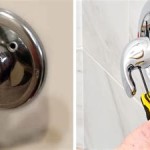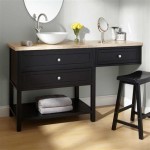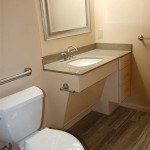Plumbing Installation: Bathroom Sink
Installing a bathroom sink involves a series of plumbing connections that demand precision and careful consideration of building codes and manufacturer specifications. A properly installed sink not only functions efficiently but also prevents potential water damage and ensures safe water usage. This article provides a comprehensive guide to installing a bathroom sink, covering essential steps from preparation to final inspection.
Before commencing any plumbing work, it is crucial to familiarize oneself with local plumbing codes and regulations. These codes dictate acceptable materials, installation methods, and inspection requirements. Compliance with these regulations guarantees the safety and longevity of the plumbing system and avoids potential fines or complications during property inspections.
Safety is paramount throughout the entire installation process. Always shut off the water supply to the bathroom before disconnecting any existing plumbing. This prevents uncontrolled water flow and potential flooding. Additionally, wear appropriate safety gear, including eye protection and gloves, to protect against debris, chemicals, and potential injuries.
Preparing for Installation
The initial phase of installing a bathroom sink centers on meticulous preparation. This involves gathering necessary tools, inspecting the new sink, and preparing the existing plumbing connections. Skipping or rushing through this phase can lead to complications later in the installation process.
A comprehensive toolkit is essential for a smooth and efficient installation. Essential tools include: a pipe wrench, basin wrench, adjustable wrench, plumber's tape (Teflon tape), putty knife, level, measuring tape, screwdriver set (both flathead and Phillips head), bucket, rags, and potentially a pipe cutter if modifications to existing pipes are required. Depending on the sink type and mounting method, additional tools like a drill and appropriate drill bits might be necessary.
Carefully inspect the new sink for any defects or damage incurred during shipping. Check for cracks, chips, and manufacturing flaws. Ensure that all necessary components, such as mounting hardware, drain assembly parts, and faucet connections, are included. If any damage or missing parts are identified, contact the supplier or manufacturer immediately for replacements.
The existing plumbing needs to be prepared to accommodate the new sink. Begin by shutting off the water supply to the bathroom. Locate the shut-off valves under the existing sink or at the main water supply for the house. Turn off both the hot and cold water supplies. Open the existing faucet to relieve any remaining pressure in the pipes. Place a bucket underneath the drain and supply lines to catch any residual water when disconnecting the old sink.
Carefully disconnect the existing drain and supply lines. Use a wrench to loosen the compression fittings on the supply lines connecting to the faucet. For the drain, loosen the slip nuts connecting the P-trap to the sink drain tailpiece and the drainpipe in the wall. If the connections are corroded or difficult to loosen, use penetrating oil to help break them free. After disconnecting the plumbing, carefully remove the old sink from its mounting location.
Clean the area where the new sink will be installed. Remove any debris, old sealant, or adhesive. Inspect the drainpipe and supply lines for any signs of corrosion or damage. If necessary, replace or repair these components before proceeding with the new sink installation. Ensure that the drainpipe protrudes sufficiently from the wall to allow for proper connection of the P-trap.
Installing the Drain Assembly and Faucet
The drain assembly and faucet are critical components of the bathroom sink. Their proper installation ensures water drains efficiently and that the faucet operates without leaks. This phase requires careful attention to detail and adherence to manufacturer instructions.
Begin by assembling the drain assembly according to the manufacturer's instructions. This typically involves inserting the drain flange into the sink drain opening and securing it with a rubber gasket, friction ring, and locknut. Apply plumber's putty to the underside of the drain flange to create a watertight seal. Tighten the locknut securely, but avoid overtightening which can damage the sink. Remove any excess plumber's putty with a putty knife.
Install the drain tailpiece to the bottom of the drain assembly. The tailpiece is a straight pipe that connects the drain assembly to the P-trap. Tighten the slip nut connecting the tailpiece to the drain assembly. Ensure that the connection is secure and watertight.
Install the faucet according to the manufacturer's instructions. This typically involves inserting the faucet shanks through the mounting holes in the sink. Secure the faucet with washers and locknuts from underneath the sink. Tighten the locknuts securely, ensuring that the faucet is properly aligned and stable. Connect the water supply lines to the faucet shanks. Use plumber's tape on the threaded connections to ensure a watertight seal. Tighten the connections with a wrench, but avoid overtightening.
If the faucet includes a pop-up drain stopper, install it according to the manufacturer's instructions. This typically involves inserting the pop-up drain stopper rod into the faucet and connecting it to the drain linkage. Adjust the linkage to ensure that the pop-up drain stopper opens and closes properly.
Connecting the Plumbing and Final Inspection
Connecting the plumbing involves attaching the water supply lines and the P-trap to the drainpipe. A thorough final inspection is essential to identify and correct any leaks or issues with the installation.
Connect the water supply lines to the shut-off valves under the sink. Use flexible supply lines to allow for easier connections and adjustments. Ensure that the supply lines are the correct length and diameter. Use plumber's tape on the threaded connections to ensure a watertight seal. Tighten the connections with a wrench, but avoid overtightening.
Install the P-trap to the drain tailpiece and the drainpipe in the wall. The P-trap is a U-shaped pipe that traps debris and prevents sewer gases from entering the bathroom. Ensure that the P-trap is properly aligned and that the connections are secure. Tighten the slip nuts connecting the P-trap to the drain tailpiece and the drainpipe. Ensure that the connections are watertight.
Turn on the water supply to the bathroom. Check for leaks at all connections, including the faucet, drain assembly, supply lines, and P-trap. Tighten any connections that are leaking. If leaks persist, disassemble the connection, inspect the components, and reassemble with fresh plumber's tape or plumber's putty.
Run water into the sink and check for proper drainage. Ensure that the water drains freely and that there are no clogs or obstructions in the drainpipe. Check the pop-up drain stopper for proper operation. Ensure that it opens and closes smoothly and that it seals the drain effectively.
Inspect the entire installation for any potential issues or hazards. Ensure that all components are securely mounted and that there are no loose connections or exposed pipes. Clean up any debris or spills from the installation area. Properly dispose of any waste materials according to local regulations.
Allow the sink to sit for several hours after installation to allow any sealant or plumber's putty to fully cure. Recheck all connections for leaks after the sealant has cured. Address any remaining leaks or issues as needed. The plumbing installation is now complete and the sink is ready for use.

How To Fit A Bathroom Sink Diy Guides Victorian Plumbing

How To Fit A Bathroom Sink Diy Guides Victorian Plumbing

Here S How Install A Bathroom Pedestal Sink
How To Install Bathroom Sink Drain Queen Bee Of Honey Dos

Bathroom Sink Plumbing Installation Diy Montreal

Installing A Bathroom Sink Drain Efficient Plumber

How To Install Bathroom Sink Drain Plumbing Replace

Bathroom Sink Plumbing Installation Diy Montreal

Bathroom Sink Plumbing 5 Essential Parts O Plus Inc The Best Plumber Drain Company In Greater Toronto Area

How To Connect A Bathroom Sink Drain
Related Posts







